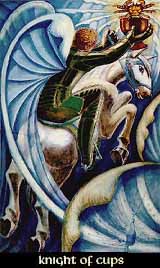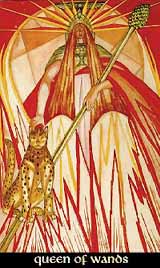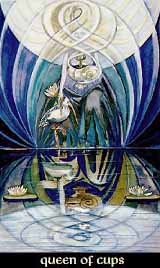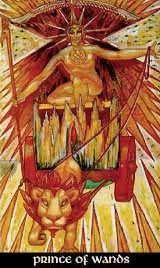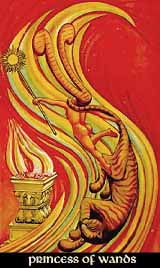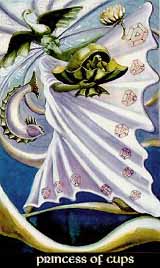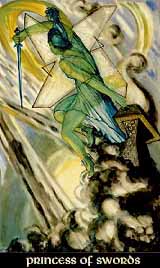The Courts Cards are a very special part of the Minor Arcana, and ever since
Tarot readers went and interpreted persons into them - such as 'a dark stranger will
come into your life' etc - especially on flea markets..
This might be somewhat romantical but will not at all serve the Court Cards right or
even well.
Court cards indeed have a strong personal touch. Unlike the numbered cards who show
the elements against the background of the 10 Sephiroth and are more likely defining
various steps of a process, the Court Cards reflect personal human attributes within
the elements, and the elements within the elements.
So a more frequently appearing of court cards within a reading implies that personal
feelings and emotions are more important than various steps of an ongoing process,
wether for the person who is asking or for the cards that are answering.
The differentiation between a personal feeling and a step of a process is very
important in reading the cards. For example the famous question 'Does he love me?'
will hardly ever get answered by any court card - since it asks for a process -
therefore the Two of Cups in the answering position is sure good news. It won't say
that *he* loves *her* or vice versa, but that love has the best chances to blossom.
![]()
As for the Court Cards, it should be remembered that Tarot cards reflect the
subconscious rather than any 'outside happenings', even when the borders might get
blurred simply because the subconscious has a far deeper presentiment of the
'outside' than the consciousness could ever figure out. Questions regarding other
persons will more likely show the own expectations and opinions than the others
themselfes, often the instinctive, unconscious perception that in most cases bears
far more truth than what the conscious prefers to see and/or figured out for itself.
It should be fairly examined in how far a card reflects the picture that one has
from another person or the reaction/feeling/expectation that the other person causes
in the own inside.
The best way to figure this out is studying the cards fairly and also studying the
own inside. Unlike common rumours going, Tarot cards won't provide a comfortable
'how-to-live-and-what-to-do-manual' - what they do is give advices and help clearing
the views into the own inside, where the answers usually can be found when only
looking close enough.
Below is just a short summary of what all court cards have in common, the 'normal'
explanations can be found within the suits.
The Knights represents the fiery side of the element, so for example the Knight of Wands is the fiery side of the Fire, The Knight of Cups the fiery side of the Water etc. Knights are strong and powerful, but their eruptions won't last too long. The Knight of Wands is like a flash, the Knight of Cups like a strong rain, the Knight of Swords a storm and the Knight of Disks an avalanche. Knights are the fathers of their elements - but not a father who cares for his family dayin, dayout, but the father who generates a child and then is on his way again.
The Knights in the Thoth deck stand as the Kings in other decks.
It has lately come up that the Knights of the Thoth deck were not at all the Kings, but the Knights or Pages, while the Princes were the Kings. Here I vehemently disagree.
In the order of the Thoth deck the line 'Knight - Queen - Prince - Princess'
represents the line 'Father - Mother - Son - Daughter'.
Crowley writes in his Book of Thoth:
The Qabalists, devising the Tarot, then proceeded to make pictures of these extremely abstract ideas of Father, Mother, Son and Daughter, and they called them King, Queen, Prince and Princess. It is confusing, but they were also called Knight, Queen, King and Princess. Sometimes, too, the Prince and Princess are called "Emperor" and "Empress".
The reason for this confusion is connected with the doctrine of the Fool of the Tarot, the legendary Wanderer, who wins the King's daughter, a legend which is connected with the old and exceedingly wise plan of choosing the successor to a king by his ability to win the princess from all competitors. (Frazer's Golden Bough is the authority on this subject.)
It has been thought better, for the present pack, to adopt the term "Knight", "Queen", "Prince" and "Princess", to represent the series Father, Mother, Son, Daughter, because the doctrine involved, which is extraordinarily complex and difficult, demands it. The Father is "Knight" because he is represented as riding on a borse.
![]()
The Queens represent the watery side of each element, the daughters of the old Kings that were replaced by the stormy Knights. The Queens are thus the complements of the Knights, they will receive the seeds from them, ferment, and transmit the original Energy and give birth to the children of their elements, complementing Fire and Water, Yin and Yang, the bright flames with the dark seas, they are the mothers of their elements.
![]()
The princes are the sons of the Queens and the Knights, representing the airy
side of their elements. The princes have the combined powers of their parents, they
are the active issue of their union and its manifestation, they are the intellectual
combinations of both. So for example the Prince of Swords is the airy side of the
element Air i.e. the air in the world of Yetzirah, created by the Fire of Yetzirah
and born in the waters of Yetzirah.
This might sound a bit complicated at first sight, but in the end has an almost
simple logic that helps a lot to understand the cards.
Princes stand as Knights or Pages in other decks.
![]()
The princessess finally are the daughters of the Knights and the Queens, the
earthly side of their elements. They represent - in short - the process that the
numbered cards show going down from Kether to Malkuth, bringing the original spirit
of each element down to the grounds of Assiah.
Crowley writes of the poor Princesses:
The Princesses have no Zodiacal attribution. Yet evidently they represent four types of human being. They are those numerous "elemental" people whom we recognize by their lack of all sense of responsibility, whose moral qualities seem to lack "bite". They are sub-divided according to planetary predominance. Such types have been repeatedly described in fiction. As Eliphaz Levi wrote: "The love of the Magus for such creatures is insensate, and may destroy him".
![]()

